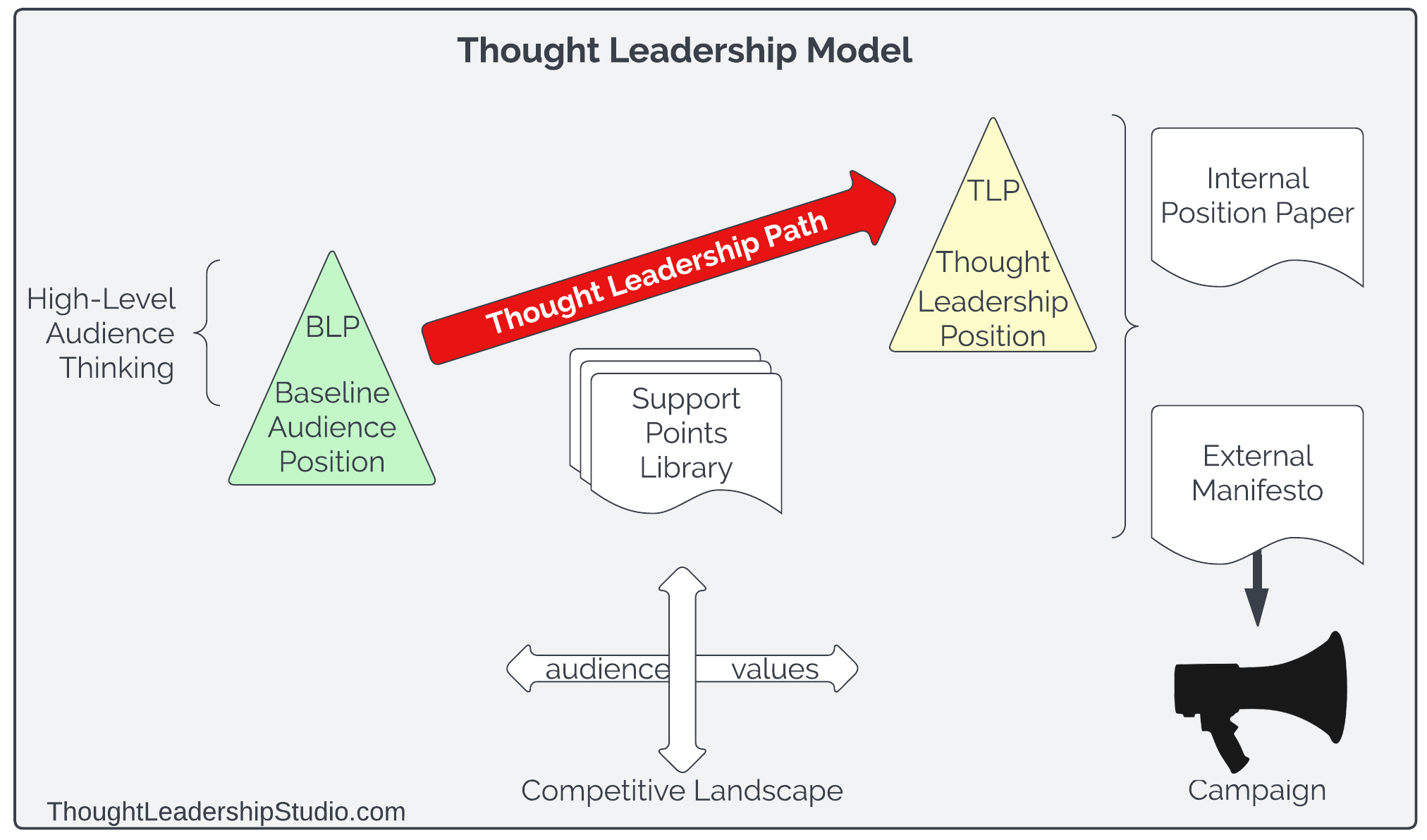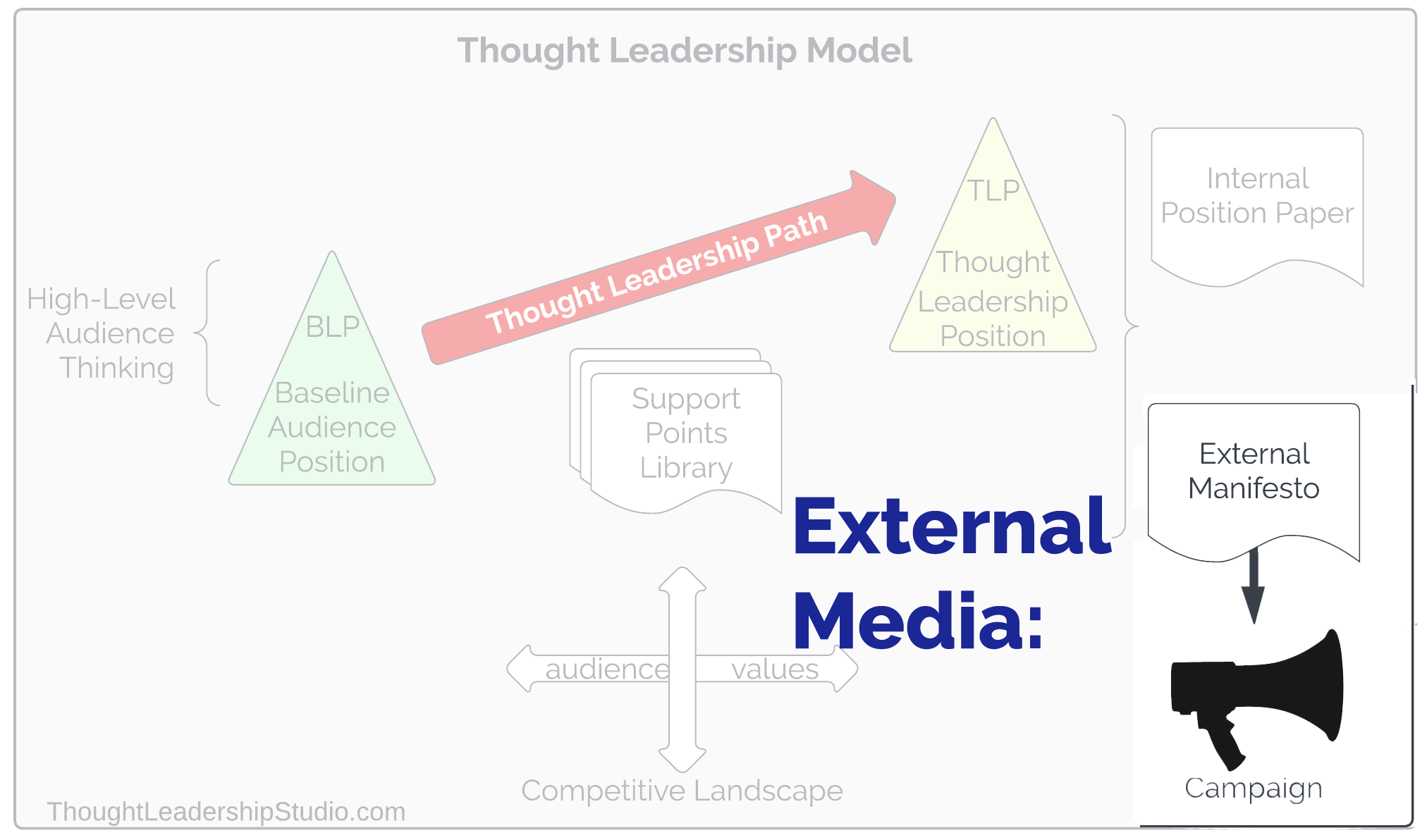Thought Leadership Studio Podcast Episodes:
How to Organize Your Ideas for Impact
Episode 21: Overcome Common Misconceptions About Thought Leadership and Create a Powerful Model Using the Structure of Language

#leadership, #marketing, #neurolinguisticprogramming, #nlp, #paradigmchange, #paradigmshifts, #thoughtleadership, #thoughtleadershipexamples, #thoughtleadershipmarketing, #thoughtleadershipmodel
Or Click here to listen or subscribe on appWhat this episode will do for you
- Understand common misconceptions about thought leadership.
- Know the difference between just conveying an idea and implementing a fully formed Thought Leadership Model
- Better understand how to organize ideas into coherent models of influence.
- Have greater clarity about what makes a message create impact.
- Gain more confidence and effectiveness in your ability to persuade.
Dangerous Misconceptions About Thought Leadership.
 I was reading yet another piece about thought leadership recently. It's message? "Thought leadership is about being seen as an expert in your field." Supporting that? "Here's the types of content you need to create as thought leadership content" And it left it at that.
I was reading yet another piece about thought leadership recently. It's message? "Thought leadership is about being seen as an expert in your field." Supporting that? "Here's the types of content you need to create as thought leadership content" And it left it at that.
That is dangerously incomplete.
That's like giving your audience a bunch of empty boxes for Christmas. They might have nice wrapping and pretty bows on them, but the boxes are completely empty. As they open the boxes, they find out there is really nothing there.
So from a distance, it looks like a nice set of presents. But your prospects don't sign up from a distance. They only sign up or purchase your product once they come close. So having nicely wrapped empty boxes isn't going to help you sell anything.
When your concept of thought leadership only includes being seen as an expert and having the right kind of media, you are in danger of the empty box syndrome.
And those aren't the only common misconceptions.
Let's bundle these misunderstandings about Thought Leadership with a few other relevant disempowering beliefs:
- The misconception that thought leadership is just about showing your expertise.
- The misconception that thought leadership is about the type of media you create.
- The misconception that a good idea is enough.
- The misconception that filler content will work.
Missing Parts
There are nine components to a proper Thought Leadership Model and only the last two are about external media.
The rest of them are about gaining insight into your audience thinking and designing a message or set of messages with plenty of supporting talking points. That's what delivers the impact by helping your audience's thinking move to a new, more empowering place.

Think of something else that has multiple parts and trying to make do with about twenty percent of them in place. It's like a house made of only external walls and paint with nothing holding it together from the inside. It's like a car with no engine, no seats, and only 2 tires.
We can dovetail creating a counterpoint to all of these partial and misleading concepts of thought leadership by addressing the missing internal components none of them include. Note the modified 9 Building Blocks of Strategic Thought Leadership model below. If we only focus on the external media, that's the bottom right 2 components (the manifesto and campaign) with none of the other 7 necessarily addressed.
That would be the equivalent of the empty boxes nicely wrapped as presents mentioned earlier.
So let's start addressing some of those missing components.

 Side note story- I recently read how a man in Turkey found a huge underground city beneath his basement.
Side note story- I recently read how a man in Turkey found a huge underground city beneath his basement.
This underground city once housed 20,000 people. It went 18 stories and 280 feet deep in places.
I bring this up because, once we start going down the rabbit hole of everything that goes into a robust Thought Leadership Model, the rabbit hole can keep going deeper and deeper.
So don't expect to learn everything about how to do it from this podcast episode. This episode is like just going the first couple stories deep.
But, like the amazing insights about the ancient civilization that emerged from discovering this underground city, just going a couple levels down can have immediate impact on your messaging, your marketing, your sales, your persuasion, or your leadership.
Thought Leadership is About Leading Thought. So to where?
Note the central components of the Thought Leadership Model in the graphic above. The Thought Leadership Path defines the vector of the movement of thought. It gives every communication greater power by providing a strong "back-story".
 Consider the Thought Leadership Path like a bridge between the islands of the old thinking and the new thinking. Then a library of supporting talking points that undermine the old thinking and support the new thinking can be built from a toolkit of dozens of persuasive language patterns sourced from fields like neuro-linguistics.
Consider the Thought Leadership Path like a bridge between the islands of the old thinking and the new thinking. Then a library of supporting talking points that undermine the old thinking and support the new thinking can be built from a toolkit of dozens of persuasive language patterns sourced from fields like neuro-linguistics.
So, the components of a Thought Leadership Model we are addressing today are:
- Old Thinking: Audience Baseline Position.
- New Thinking: Thought Leadership Position.
- Path between: The Thought Leadership Path, supported by talking points that impact thinking, AKA Support Points.
The Support Points are like the pillars holding up the bridge between the islands of the old thinking and new thinking.
Let's run through a couple of examples to illustrate the point of organizing thinking for impact with Thought Leadership Model building.
Example One: From "Showing Expertise is Enough" to "Building a Well-Structured Thought Leadership Model is Necessary."
Audience Baseline Position:
If you appear to be an expert, you are doing thought leadership. Thought Leadership Position:
That is incomplete: You will only have the maximum positive impact if you build a full Thought Leadership Model. Support Points for a Thought Leadership Path:
- If you only demonstrate your expertise, you might look smart but they won't care. Working from a structure to move audience thinking on levels higher than knowledge has an impact you can't miss. (Pattern type: A-B Outcome)
- Doesn't it create more impact to use the greater power of a complete Thought Leadership Model? (Pattern type: Higher Values)
- Showing expertise isn't necessarily leading the audience to get more value out of what you sell, elevate it to a higher purpose, or make a smarter buying decision and those are what add value with the information. (Pattern type: Shift Criteria)
- Building a robust thought leadership model is like building a house where the foundation, the structure needs to be complete. Just sharing that you have knowledge is like the paint on the house. It looks nice but doesn't go deep. (Pattern type: Metaphor)
- Thought leadership isn't simply about showing what you know, it's about empowering your audience to get more out of what you offer. (Pattern type: Shift the Outcome)
Example Two: "Thought Leadership is About The Message First, The Media Second."
Audience Baseline Position:
If I have the right types of media, I have thought leadership. Thought Leadership Position:
The media means nothing if it doesn't contain a properly-structured message. A powerful back-story provided by a full Thought Leadership Model is necessary for the right media types to have their full impact. Support Points for a Thought Leadership Path:
- If you only consider what type of media, your influence will be shallow at best. It will only look like thought leadership from a distance. Like with a vintage car with surface rust, as people draw close they will notice the flaws and get turned off. If you build a well constructed thought leadership model, however, the closer they get, the more they will appreciate it as you truly help them gain a fresh, helpful perspective. (Pattern types: A-B Outcome, Metaphor)
- Doesn't the maximum positive impact of true leadership only come from fully considering both the destination and the journey of thinking? (Pattern type: Higher values)
- It isn't about the right media types, it is about the audience empowerment that only comes from fully applying a well-built model of influence with the media you use. (Pattern type: Shift the Outcome)
*Keep in mind a typical Strategic Thought Leadership program will include multiple Thought Leadership Models, each with a Thought Leadership Path including 20 or more support points. All of which fuels a marketing, influence, leadership, or PR campaign and are encapsulated in many types of media. They are also typically informed by extensive "audience listening" market research.
These examples are just very partial demonstrations of Strategic Thought Leadership Model-building to convey a little bit about how it works.
Don't Confuse the Media with the Message
Many promote the idea of "Thought Leadership Media" and recommend producing media like:
- Unique Research
- White Papers.
- eBooks
- Podcasts
But, without a well organized strategic message encapsulated within them, they aren't leading thought anywhere.
The Question is Where You are Leading Thinking
Some questions to answer:
- Who am I leading?
- Where are they starting from?
- Where am I taking them to?
- What makes the journey worthwhile to them?
- How will they know it is worthwhile?
By understanding and using the 9 building blocks of Strategic Thought Leadership to fill out a profound back-story of one or more Thought Leadership Paths, you can transcend these misunderstandings about what thought leadership is and succeed at building and positively impacting an engaged, appreciative audience.
***************************************
Free Stuff and Offers Mentioned in Podcast
***************************************